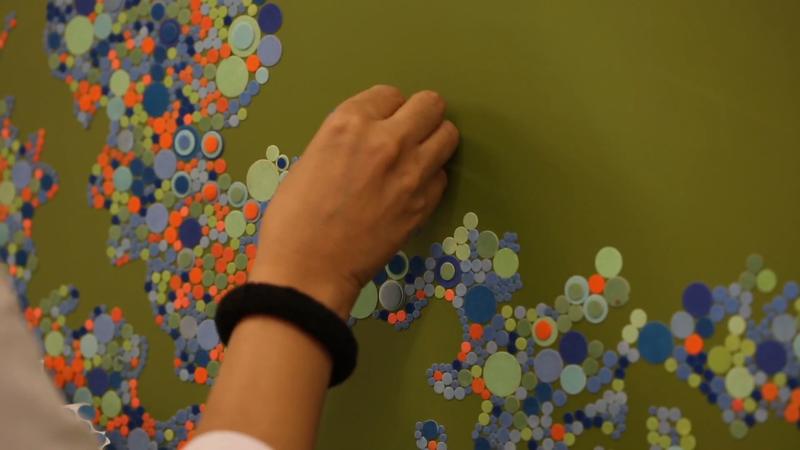During her residency Bharti Kher spent a month in the Museum galleries looking. Chairs, paintings, objects, and fabrics—nothing escaped her eye. Kher found special interest in the pairs of animal forms that appear all around the courtyard as well as the Persian and Arabic diagrams and story illustrations in the Tapestry Room. In archives she looked at Gardner’s travel albums and collection inventories. However, it was the things that got left behind in the process of archiving, documenting, and conserving that Kher felt drawn to. These included saved pieces of string, small labels, pressed flowers, and blotting paper.
Kher’s residency allowed her time to write, think, and draw in the apartment. She also had the opportunity to create a plaster cast of a pregnant woman’s torso which she shipped back to her studio. Kher attended talks, visited other museums and went on a whale watch. Chronicle featured a glimpse into her life at the Gardner in a program that aired about the Fenway Cultural District.
In 2015, Kher was the sixth artist to create a work for the Gardner Museum’s Façade art space. All Who Wander Are Not Lost reflects on maritime travel, her interest in mapping and typography and the migration of people in Africa, the Middle East and Europe. Born and raised in England, the artist moved to New Delhi in the early 1990s after her formal training in the field. Consequently, the concept of home as the location of identity and culture is constantly challenged in her work. The image Kher chose for the Façade was taken from a volume of the 1950 Larousse International political and economical Atlas on which Kher had placed thousands of bindi. Kher frequently uses the bindi, a mark indicative of the third eye worn by the Indian women on their foreheads, as a central motif in her work. She often refers to her mixed media works with bindis, as “action paintings.” Painstakingly placed on the surface one-by-one to form a design, the multi-colored bindis represent custom, often inflexible, as well as the dynamic ways in which it is produced and consumed today.
Kher returned in 2017 to install a selection of drawings, diary entries, photographs and other works she produced while living at the Gardner. The exhibition reveals a deeply personal journey and offers a poetic spin on the Museum’s art and atmosphere. The also artist conceived and produced, Bharti Kher: Sketchbooks and Diaries, in conjunction with her exhibition.
Bharti Kher’s (b. 1969, England) is an art of dislocation and transience, reflecting her own, largely itinerant life. Born and raised in England, the artist moved to New Delhi in the early 1990s after her formal training in the field. Consequently, the concept of home as the location of identity and culture is constantly challenged in her body of work. In addition to an autobiographical examination of identity, Kher’s unique perspective also facilitates an outsider’s ethnographic observation of contemporary life, class and consumerism in urban India.
Presently, Kher uses the bindi, a dot indicative of the third eye worn by the Indian women on their foreheads, as a central motif in her work. Bharti Kher often refers to her mixed media works with bindis, the mass-produced, yet traditional ornaments, as “action paintings.” Painstakingly placed on the surface one-by-one to form a design, the multi-colored bindis represent custom, often inflexible, as well as the dynamic ways in which it is produced and consumed today. The artist is also known for her collection of wild and unusual resin-cast sculptures and her digital photography.
Bharti Kher was born in London in 1969. She studied at Middlesex Polytechnic, London, and went on to receive her Bachelor’s degree in Fine Art Painting with honors from New Castle Polytechnic, in 1988. Her work has been exhibited globally including at the MAXXI Museum, Roma; Centre Pompidou, Paris; The Saatchi Gallery, London; Tel Aviv Museum of Art; Museum of Contemporary Art, Tokyo; Mori Art Museum, Tokyo; and Astrup Fearnley Museum of Modern Art, Oslo; with solo shows at the Rockbund Art Museum, Shanghai; Kukje Gallery, Seoul; Galerie Perrotin, Hong Kong and Paris; Parasol Unit Foundation for Contemporary Art, London; and Nature Morte, New Delhi. Kher lives and works in New Delhi.
